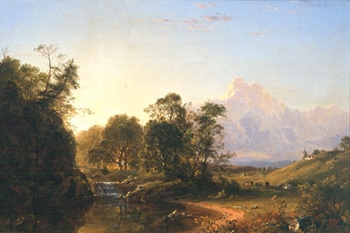
Otter Creek, Middlebury, Vermont, Frederick Edwin Church. 1854. Source: Middlebury College Museum of Art.
The landscape of Vermont changed dramatically when Europeans colonized North America and displaced and marginalized the Native peoples who dominated the region before the eighteenth century. For early European colonists, New England was seen as a wild, pristine landscape prime for clearing and cultivation. However, “a land is only ‘wild’ to those who do not know how to survive in it.” [ref] Albers, Hands on the Land. [/ref] Agriculture was not new to Vermont with the arrival of Europeans—near the mouth of the Winooski River, there is evidence of Abenaki corn and bean cultivation that goes back at least to 1450. However, for Abenaki people agriculture was only supplemental to hunting and gathering wild foods, since the short growing season, Abenaki communities’ mobility around the year, and local resource availability made agriculture less productive than their other pursuits.
As Europeans began to occupy New England they transformed the Vermont landscape, often in the image of Old-World models. Settlers cleared forests and drained wetlands to construct farmland to support sedentary cultures like those they left behind in Europe. Today in Vermont, the arrangement of pastures and fields in the Champlain Valley, for instance, follows the grid-like structure of English-derived Connecticut Yankee field patterns, while in parts of the Northeast Kingdom fields are arranged in the long rows distinctive of French Canadian agriculture. In Vermont, settlement was more diffuse than in southern New England, where communities were often more tight-knit and spatially restricted. Over the course of the second half of the eighteenth century, settlements had expanded across most of the state, and the population rose from a few thousand to over 150,000 by the turn of the century [ref] Ibid. [/ref] With a rising population, agriculture expanded across the state and forest cover gave way for the raising of livestock and crops.
After the Civil War, tourism became an increasingly important driver of landscape change in Verrmont. The Romanticism of the time which esteemed sublime and picturesque scenery encouraged many tourists from urban areas in the Northeast to visit the rugged mountains of the Adirondacks and New Hampshire’s White Mountains for recreation and leisure. [ref] Klyza and Trombulak, The Story of Vermont. [/ref] In Vermont, however, urban tourists admired the bucolic, pastoral landscape rather than the rugged and sublime landscapes of more mountainous regions nearby. Tourist infrastructure expanded across the state, including mountaintop hotels such as one on Snake Mountain, and by the 1950s the ski industry became a major foundation of Vermont’s tourist industry. For many visitors, Vermont’s image “represent[s] a simpler and slower version of life in America,” and their love of Vermont’s pastoral landscape reflects the “deep-seated American love and respect for agriculture and small-town life, even though the vast majority of Americans do not seem to want to live such a life.” [ref] Ibid. [/ref]